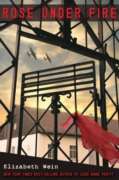
Rose under Fire
Written by Elizabeth Wein
Disney Hyperion, 2013, 368 pp.
ISBN-13: 978-1423183099
Elizabeth Wein, the author of this World War II YA novel, was born in 1964 New York City and moved to England with her family when she was three. She also spent time living in Jamaica and Pennsylvania as a child. She now resides in Scotland with her husband and two children. Well acquainted with folklore and inspired by British history, she based her Arthurian series on British legend and drew on World War II history with Code Name Verity and Rose under Fire. Like her main characters these two novels, she and husband are pilots.
Rose under Fire serves as companion novel to Code Name Verity (2012) in which Wein first introduced the character of Rose Justice. The connection is made through the main characters’ friendship with a mutual friend, Maddie. In Rose under Fire, Rose works as an ATA (Air Transport Auxiliary) worker, ferrying Allied planes between England and Paris. The initial portion of the story details the daily routine of Rose and other ATA pilots. It is not until Rose is captured by the Nazis that the story shifts to a historically accurate chronicle of Rose’s daily existence in Ravensbruck, an all-female concentration camp.
In Ravensbruck, a group of women befriend Rose and help her during her time in the camp. Among Rose’s fellow prisoners are a group of women referred to as the “rabbits”. Rabbits are Polish prisoners who were medically experimented on by Nazi doctors. The rabbits who lived through the experiments are maimed, mutilated, and bear both exterior and interior scars from the experiments. One of the main themes throughout this story is the need for Rose to bear witness to the world of the rabbits and tell their story as well as to record other atrocities at the camp. The novel is written in a journal format and offers Rose’s perceptions of events.
The novel provides explicit details, such as describing the stitching on a handkerchief, the way to tip a doodlebug, or recounting the Nuremburg Trails. Wein includes a list of primary sources used in researching historical events. Appropriate as a realistic portrayal of war, this book demonstrates the status of women during World War II and their treatment in concentration camps. Rose under Fire is a suitable read for individuals 13 and up and can be read as a companion to Code Name Verity or on its own. The only cautionary warning concerning this book is that rape and torture are part of the story as are descriptions of the ways humans can inhumanly treat one another. However, the educational benefits of learning about the treatment and role of female POWs as well as concentration prisoners is important. In the tradition of Rosie the Riveter, this story adds one more narrative to the growing body of work regarding female contributions to the war effort.
There are numerous themes that can be used to pair books with Rose under Fire. The most lasting themes are those of solidarity (especially amongst females), defiance, hope, and bringing the truth to light by bearing witness. A text to pair with the theme of solidarity is the book Dirty Work (2007) by Julia Bell. Dirty Work tells the story of two girls, one of them abducted, in an international prostitution ring. The two girls understand that if they are ever going to get away, they must learn to trust each other.
Texts to pair with the theme of defiance are: In Defiance of Hitler: The Secret Mission of Varian Fry by Carla Killough McClafferty (2008), The Book Thief by Markus Zusak (2006), and Beyond Courage: The Untold Story of Jewish Resistance During the Holocaust by Doreen Rappaport (2014). In Defiance of Hitler tells the story of a young New York journalist who secretly helps refugees in Nazi-occupied France escape. The Book Thief tells the story of Liesel Meminger a girl who steals books and then shares the stories with her neighbors during bombings, and the Jewish man hiding in her basement. Beyond Courage offers stories of Jews who sabotaged the Nazis in order to help other Jews during the Holocaust.
Texts to pair with the theme of hope are Call Me Hope: A Novel by Gretchen Olson (2008), and Kids of Kabul: Living Bravely Through a Never-Ending War by Deborah Ellis (2012). Call Me Hope tells the a story of an 11-year-old girl who is verbally abused by her mother but instead of running away, finds strength, gets help and confronts her mother. Kids of Kabul tells the account of 24 children between the ages of 10 and 17 living in a war torn country yet wanting to acquire education and life experiences and to have fun.
Texts to pair with the theme of bringing the truth to light by bearing witness are My Secret Camera: Life in the Lodz Ghetto by Frank Dabba Smith and Mendel Grossman (2008), Bearing Witness: Stories of the Holocaust by Bernie Glassman (1999), Between Shades of Gray by Ruta Sepetys (2011), and Where the Action Was: Women War Correspondents In World War II by Penny Coleman (2002).
Megan McCaffrey, Governors State University, Illinois
WOW Review, Volume VII, Issue 1 by Worlds of Words is licensed under a Creative Commons Attribution-NonCommercial-ShareAlike 4.0 International License. Based on work at https://wowlit.org/on-line-publications/review/vii-1/
